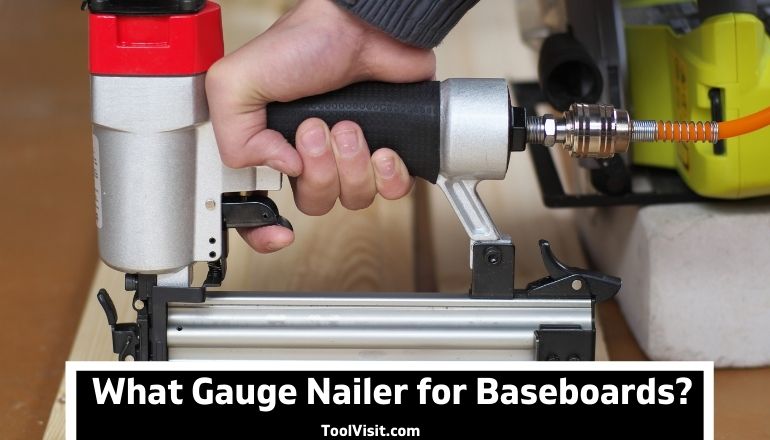
Baseboards, without a doubt, enhance the appearance of a home. If the baseboard is small, the room looks dull.
And the room itself becomes majestic when it is fantastic. It makes your room an attractive architectural element by covering the joint between the wall and the floor.
But nailing a baseboard is not that easy. And whenever it comes to nailing baseboards, everyone gets confused.
Different nails are available, and they are all different in size, length, and width. What gauge nailer for baseboards?
We will try to answer this question in this article. We will also talk about other important questions that might come to your mind concerning baseboard nailing.
15 or 16 Gauge for Baseboards
A baseboard is a thin protective layer. It can be replaced easily if damaged. And you must take this slimness while choosing nails for your baseboard.
However, using 15 or 16 gauge nails is the best option. This nail size is perfect for connecting baseboards to the wall for several purposes.
With such thin baseboards, you want a thin nail that does not make a noticeable indication.
Besides, it has to be sufficient to fix itself firmly to the wall. A 15 or 16-gauge pin is enormous in length but small enough to be barely visible. That’s why there is significantly less work when you use a 15 or 16 gauge.
18 Gauge Nails (Brad Nailer) for Baseboards
Your baseboards can be sealed with an 18-gauge Brad Nailer. But, if we compare a 15 or 16-gauge nail to an 18-gauge nail, you may find it less preferable. It lacks the ability to hold.
You’re probably asking whether you need an 18 gauge or 16 gauge nailer for baseboard trims. We suggest using a 16-gauge nail gun if your baseboards are thicker than 1/2 inch.
A brad nailer deals with nails that are thinner (0.0475 inches) and have a width of 1 1/4 to 2 inches. The size of the 15G and 16G nails is wider. It improves their gripping power.
18-gauge nails, on the other hand, are better for thin, easily separated trims.
What is the Best Way to Nail Baseboards?
A nail gun is without a doubt the most effective way to install baseboards. The problem is, which nail gun do you require? And that can be a little tricky, as the choice depends on your budget or other uses for a nail gun.
For the most part, a finish nail gun will serve when installing baseboards. They are very cost effective. They are reasonably priced (most are between $80-$200) and will last for years.
You can also use it for a wide range of other home renovations. If you don’t really want to purchase one, inquire around. You’ll almost certainly be able to rent someone else’s.
How do you Nail Baseboards to Molding?
For nailing baseboards, there are two main techniques. You can nail it with or without the use of a nail gun. But a nail gun is strongly preferred. Let’s take a look at three fundamental steps to follow when molding baseboards-
Step 1: Make a note of your studs to have an idea how far you can nail the baseboard. Locate the studs with a stud finder. A straightforward way is to put the painter’s tape over the baseboard along with every stud.
Step 2: Prepare your tools. If you’re going to use a nail gun, you’ll probably need an air compressor.
If you’re going to use a cordless nailer, make sure the battery is fully charged and ready to go. If you’re going to use a hammer, you must get the right size nail set for your nails.
Step 3: Begin thoroughly nailing now. Use the nail set to get the pin underneath the baseboard.
What Size Nails for Baseboard Trim?
It is always preferable to have long, thin nails. And the method of determining the size of a nail is simple. Just keep two terms in mind.
The ‘d’ in baseboard nail size refers to the length of the nail. The gauge is the size or thickness of the nail. Knots can be difficult to extract with a long, thin pin because it is sensitive to denser or thicker substances.
The reason this nail size is the right is that the baseboard itself is narrow. The larger your nail, the deeper your impression becomes.
What Kind of Paint for Baseboards?
You’ll find three color choices when painting the baseboards. There is also a variety of sheens available.
They are water-based paint, Acrylic-Alkyd hybrid paint, and oil-based paint. Professional painters traditionally use oil-based paint. It dries quickly and neatly, giving it a professional appearance.
Water-based paint is not as long-lasting as oil-based paint. Water-based paints dry quickly, are easy to clean, and are environmentally friendly.
Acrylic-alkyd hybrid is made with both oil-based and water-based elements. It dries faster and cleaner. It has a more negligible effect on the environment. That’s why it is the best paint available for your baseboards.
However, not all manufacturers produce acrylic-alkyd. Even if they do, not all produce it in all sheens.
Now, you know what gauge nailer for baseboards you need to use. We attempted to resolve all of your concerns about the baseboard installation project here.
Please don’t be afraid to approach a professional if you have any further issues or queries.